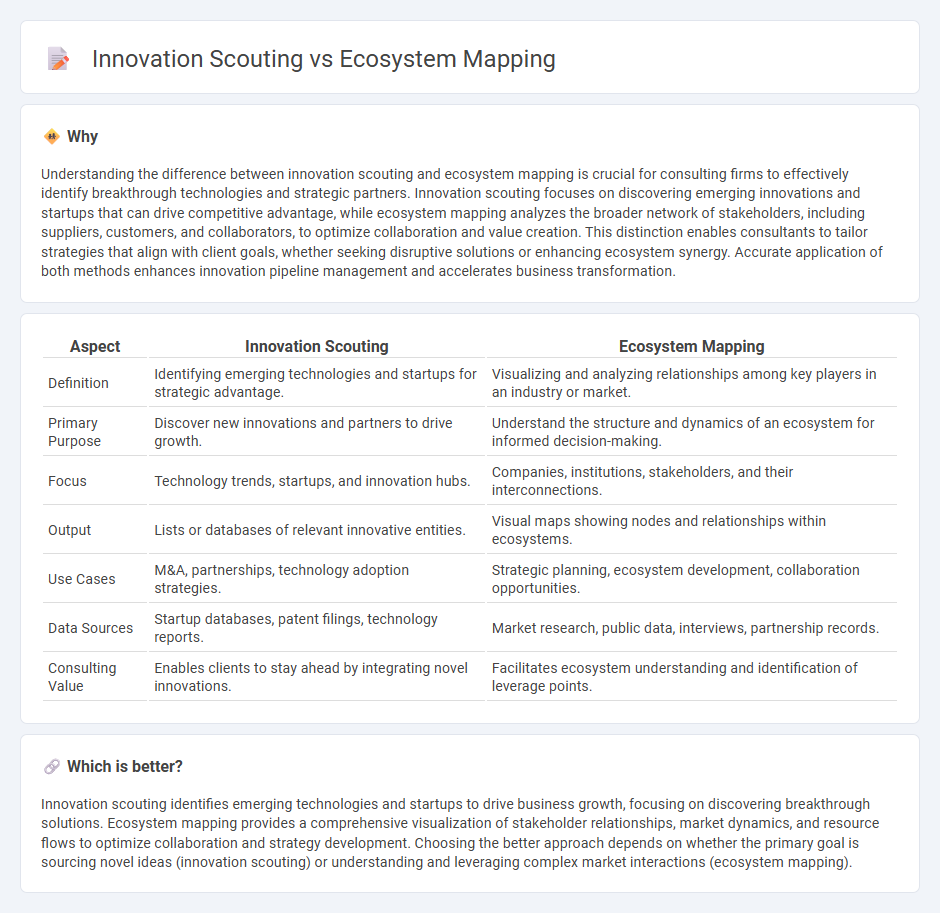
Innovation scouting identifies emerging technologies and startups to drive business growth, focusing on discovering novel solutions outside the organization. Ecosystem mapping analyzes the broader network of stakeholders, partnerships, and market dynamics to optimize collaboration and strategic positioning. Explore how combining innovation scouting with ecosystem mapping can enhance your consulting strategy.
Why it is important
Understanding the difference between innovation scouting and ecosystem mapping is crucial for consulting firms to effectively identify breakthrough technologies and strategic partners. Innovation scouting focuses on discovering emerging innovations and startups that can drive competitive advantage, while ecosystem mapping analyzes the broader network of stakeholders, including suppliers, customers, and collaborators, to optimize collaboration and value creation. This distinction enables consultants to tailor strategies that align with client goals, whether seeking disruptive solutions or enhancing ecosystem synergy. Accurate application of both methods enhances innovation pipeline management and accelerates business transformation.
Comparison Table
| Aspect | Innovation Scouting | Ecosystem Mapping |
|---|---|---|
| Definition | Identifying emerging technologies and startups for strategic advantage. | Visualizing and analyzing relationships among key players in an industry or market. |
| Primary Purpose | Discover new innovations and partners to drive growth. | Understand the structure and dynamics of an ecosystem for informed decision-making. |
| Focus | Technology trends, startups, and innovation hubs. | Companies, institutions, stakeholders, and their interconnections. |
| Output | Lists or databases of relevant innovative entities. | Visual maps showing nodes and relationships within ecosystems. |
| Use Cases | M&A, partnerships, technology adoption strategies. | Strategic planning, ecosystem development, collaboration opportunities. |
| Data Sources | Startup databases, patent filings, technology reports. | Market research, public data, interviews, partnership records. |
| Consulting Value | Enables clients to stay ahead by integrating novel innovations. | Facilitates ecosystem understanding and identification of leverage points. |
Which is better?
Innovation scouting identifies emerging technologies and startups to drive business growth, focusing on discovering breakthrough solutions. Ecosystem mapping provides a comprehensive visualization of stakeholder relationships, market dynamics, and resource flows to optimize collaboration and strategy development. Choosing the better approach depends on whether the primary goal is sourcing novel ideas (innovation scouting) or understanding and leveraging complex market interactions (ecosystem mapping).
Connection
Innovation scouting identifies emerging technologies and startups within a competitive landscape, while ecosystem mapping visualizes the relationships and key players in that landscape. Together, they provide a comprehensive overview of market opportunities and potential collaboration partners for business growth. Leveraging both techniques enables consultants to strategically guide companies in adopting disruptive innovations.
Key Terms
**Ecosystem Mapping:**
Ecosystem mapping involves systematically identifying and analyzing all key players, relationships, and resources within a business environment to understand market dynamics and collaborative opportunities. This approach highlights strategic partnerships, technology trends, and competitive landscapes, enabling organizations to optimize their innovation and growth strategies. Explore more about how ecosystem mapping drives informed decision-making and accelerates business success.
Stakeholder Analysis
Ecosystem mapping systematically identifies and visualizes key stakeholders, their relationships, and influence within an innovation environment, enhancing strategic decision-making. Innovation scouting, by contrast, targets the discovery of emerging technologies and partners, often relying on stakeholder insights to pinpoint valuable external opportunities. Explore how integrating stakeholder analysis into both approaches can accelerate innovation success.
Network Visualization
Ecosystem mapping emphasizes the visualization of relationships among stakeholders, enabling companies to understand complex networks and identify strategic partners within an innovation landscape. Innovation scouting prioritizes discovering emerging technologies and startups by analyzing innovation trends and market opportunities, often leveraging network visualization to pinpoint key innovators. Explore how integrating network visualization enhances both approaches to accelerate innovation and strategic decision-making.
Source and External Links
How to Create an Ecosystem Map | Miro - An ecosystem map is a dynamic tool that visually represents key components and their connections in a complex system, helping organizations see the big picture and identify opportunities or gaps by mapping players, processes, and touchpoints around a business or project environment.
Ecosystem Map | Service Design Tools - An ecosystem map synthesizes all key roles influencing the user, organization, and service environment by placing the user at the center and connecting all entities based on types of exchanged value to uncover gaps and opportunities through visualizing relationship loops.
What is Ecosystem Mapping? A Beginner's Guide - Ecosystem mapping involves visually representing key entities and their relationships within a system, with various map types such as stakeholder maps, network maps, resource maps, influence maps, and geographic maps, each serving distinct purposes like partnership building, social impact analysis, or policy advocacy.
 dowidth.com
dowidth.com